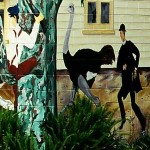8
Artist: Malcolm Pitkeathly, Katikati
Year: 1992
Medium: Acrylic on Block Wall & Pressed Steel
Size: 62 sq m.
Sponsored By: Cellar 74, Community Donations

In 1897 the Rev. W Katterns established an experimental ostrich farm to supplement his small stipend as Anglican vicar. He began with one pair, but being prolific breeders (the hen laying 30 eggs in 1898), within three years he had 15 birds. Top quality white wing feathers were valuable and feathers from one bird were worth between three pounds ten shillings and four pounds ten shillings, quite a lot of money in those days.
The problem was keeping the birds free of lice which ruined the feathers by eating across their filaments… and keeping them from escaping was another problem. Even though the most rudimentary fencing was said to keep them in, this was not true and they frequently escaped, sometimes finding their way to the main street of the village, their long, bare legs capable of travelling at speed and kicking out at the unwary. Unfortunately hats trimmed with ostrich feathers went out of fashion.
The flock remained until after the end of the First World War when the last remaining ostrich was chased by a dog and met its end in a local stream. Now ostriches and emus have returned to favour and are farmed in Katikati once more.


